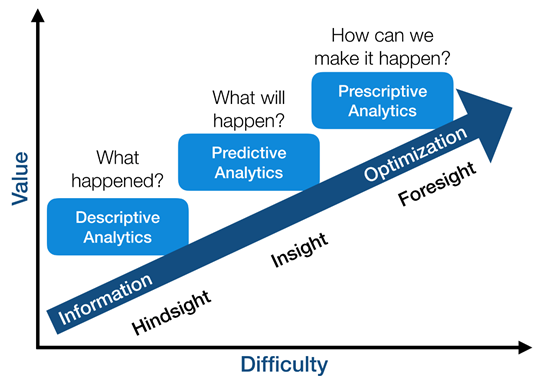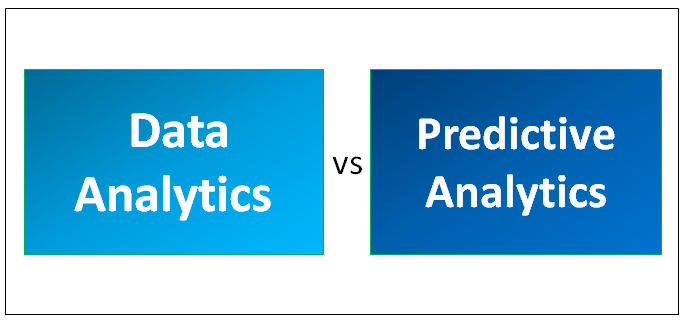Updated April 28, 2023
Difference Between Data Analytics vs Predictive Analytics
Analytics uses data, machine learning, statistical analysis, and mathematical or computer-based models to get improved insight and make better decisions. Analytics is “transforming data into actions through analysis and insight in the context of organizational decision-making and problem-solving.” Analytics is supported by many tools such as Microsoft Excel, SAS, R, and Python(libraries). In this post, let us learn data and predictive analytics in detail.
There are mainly three types of analytics: descriptive, predictive, and Prescriptive.

- Descriptive Analytics: This type summarizes or turns data into relevant information. In other words, it outlined what had occurred. This type of analytics has some meaningful impact but won’t be much helpful in forecasting.
- Predictive Analytics: Predictive analytics involves advanced statistical modeling, data mining, and one or more machine learning techniques to dig into data and allows analysts to make predictions. People use predictive analytics to forecast future events.
- Prescriptive Analytics: This form of analytics is one step above descriptive and Predictive Analytics. With this type of analytics, we can predict the possible consequences based on different choices for action; it can also be used to find the best course of action for any pre-specified outcome.
Head-to-Head Comparison Between Data Analytics vs Predictive Analytics (Infographics)
Below are the top 6 Comparison between Data Analytics vs Predictive Analytics:
Key Differences Between Data Analytics vs Predictive Analytics
Let’s understand a few differences between Data Analytics vs Predictive Analytics similarly looking terminologies:
- Data analytics (DA) involves processing and examining data sets to conclude the information those data sets consist of. Predictive analytics helps predict the future by inspecting historical data thoroughly, detecting patterns or relationships in these data, and concluding these relationships in time.
- Data analytics uses tools and techniques to enable businesses to make more informed, real-time, and pragmatic business decisions. Predictive analytics can predict risk and find a relationship in data not readily apparent with traditional analysis.
- Data analytics involves finding hidden patterns in a large dataset to segment and group data into logical sets to find behavior and detect trends. In contrast, Predictive analytics consists of the use of some advanced analytics techniques.
- Using Data Analytics, data scientists and researchers generally verify or disprove scientific models, theories, and hypotheses. Whereas Predictive analytics, with increased use of specialized systems and software, helps Data scientists and researchers to bring confidence into predictions and possible outcomes.
- Data Analytics is the science of using raw data and generating purposeful information with a defined objective that brings conclusions about that information. Data Analytics uses traditional algorithmic or mechanical processes to build deep insights. For example, running through several data sets to look for meaningful correlations between each other. Whereas Predictive analytics uses advanced computational models and algorithms to build a forecast or prediction platform, a commodities trader might wish to predict short-term price movements, collection analytics, fraud detection, etc.
- For working in Data Analytics, one needs strong statistical knowledge though for working in the Predictive analytics segment, one must have strong technical and fundamental statistical understanding. They may need to use and work on technological tools like SAS, R, and Hadoop.
- Companies generally use data analytics for business-to-consumer (B2C) applications. Many organizations collect, store, analyze and cleanse data associated with their customers, business partners, market competitors, etc. Data Analytics is then used to study trends and patterns. Predictive analytics facilitates future decision-making. For example, a social networking site collects data related to its users regarding their interests, community likings, and other segment preferences according to specified criteria such as age, gender, and, most important, demographics. Predictive analytics reveals the most probabilistic future product buy or preferred shopping items for such users.
Data Analytics vs Predictive Analytics Comparison Table
The comparison table between Data Analytics vs Predictive Analytics is explained below:
| Basis for Comparison | Data Analytics | Predictive Analytics |
| Form
|
Data analytics is a ‘general’ form of Analytics used in businesses to make data-driven decisions. | Predictive analytics is a ‘specialized’ form of analytics businesses use to predict future-based outcomes. |
| Structure | Data Analytics consists of data collection and analysis in general and could have one or more uses. | Predictive analytics consists of Defining a Project and data collection, Statistical Modelling, Analysis and Monitoring, and then predicting an outcome. |
| Data | Raw data is churned to get clean data for doing Data Analytics. | Clean Data is provided for doing Predictive Analytics. |
| Sequence | The sequence for data analytics is as follows: collect the data, inspect it, clean and transform it, and reach conclusions. | Predictive Analytics is sequenced: Model the Data, Train the Model, and Predict and Forecast the outcome. |
| Outcome
|
The outcome of Data Analytics could be predictive or not; it depends on the business case requirements. | Predictive analysis allows us to declare assumptions and hypotheses and tests them using statistical models after that predictive model gives you the ability to create an exact model of the future. |
| Usage | Businesses can use data analytics to uncover hidden patterns, identify correlations, determine customer preferences and market trends, and find other helpful information to help them make more informed decisions. | Predictive analytics helps answer questions such as “What will happen if demand goes down by 10% or supplier prices go up by 5%?” “What do we presume to pay for fuel for the next few months?” What will be the risk of losing money in a new business enterprise?” |
Conclusion
Organizations collect huge amounts of data today. This data could be related to customers, business partners, application users, visitors, internal employees, external stakeholders, etc. Analysts churn and categorize this data to identify and analyze patterns.
Data analytics refers to various tools and techniques involving qualitative and quantitative methods and processes, which utilize this collected data and generate an outcome to enhance efficiency and productivity, reduce risk and increase business gain. Data analytics techniques vary from organization to organization according to their requirements.
Predictive Analytics, as a subset of Data analytics, is a specialized decision-making tool that uses advanced technological assets and progressive statistical-based algorithms and models to generate future predictions so businesses can focus and spend their money and energies toward more positive and expected outcomes.
Recommended Articles
This has been a guide to Data Analytics vs Predictive Analytics. Here we have discussed Data Analytics vs Predictive Analytics head-to-head comparison, key differences, infographics, and comparison table. You may also look at the following articles to learn more –




